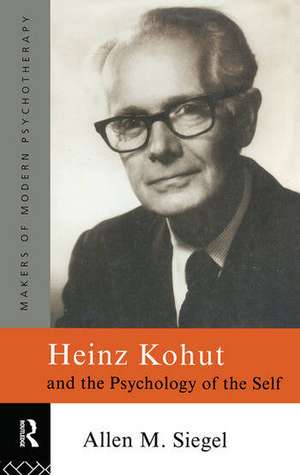Heinz Kohut and the Psychology of the Self: Makers of Modern Psychotherapy
Autor Allen M. Siegelen Limba Engleză Paperback – 10 oct 1996
Preț: 272.83 lei
Preț vechi: 287.20 lei
-5% Nou
Puncte Express: 409
Preț estimativ în valută:
52.21€ • 56.69$ • 43.86£
52.21€ • 56.69$ • 43.86£
Carte disponibilă
Livrare economică 02-16 aprilie
Livrare express 18-22 martie pentru 25.94 lei
Preluare comenzi: 021 569.72.76
Specificații
ISBN-13: 9780415086387
ISBN-10: 0415086388
Pagini: 240
Ilustrații: 18 line drawings
Dimensiuni: 138 x 216 x 20 mm
Greutate: 0.3 kg
Ediția:1
Editura: Taylor & Francis
Colecția Routledge
Seria Makers of Modern Psychotherapy
Locul publicării:Oxford, United Kingdom
ISBN-10: 0415086388
Pagini: 240
Ilustrații: 18 line drawings
Dimensiuni: 138 x 216 x 20 mm
Greutate: 0.3 kg
Ediția:1
Editura: Taylor & Francis
Colecția Routledge
Seria Makers of Modern Psychotherapy
Locul publicării:Oxford, United Kingdom
Public țintă
Postgraduate, Professional, and Professional Practice & DevelopmentRecenzii
Self Psychology is a vigorous branch of psychoanalysis and should be better known and understood here... I recommend this book as an excellent introduction to the work of Heinz Kohut. - Psychoanalytic Psychotherapy
Cuprins
List of figures, Acknowledgments, Introduction, 1. The Viennese Chicagoan, 2. The classical foundation of Kohut's thought, 3. Early papers: emerging strands of a new cloth, 4. Toward a psychology of the self, 5. Analysis of the Self: Part I, The idealized parental imago, 6. Analysis of the Self: Part II, The grandiose self, 7. The Restoration of the Self: Part I, Innovations in theory, 8. The Restoration of the Self: Part II, Clinical considerations, 9. The two analyses of Mr. Z, 10. How Does Analysis Cure?: Part I, Theoretical reftections, 11. How Does Analysis Cure?: Part II, The therapeutic process reconsidered, 12. Last words, 13. Critique and conclusions, Glossary, Chronology, Bibliography of the work of Heinz Kohut, General bibliography, Index
Descriere
Kohut believed that narcissistic vulnerabilites play a significant part in the suffering that brings people for treatment. Siegel uses examples from his own practice to show how Kohut's theories can be applied to other forms of treatment.

























